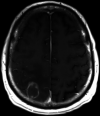Successful treatment of central nervous system lymphoproliferative disorder in a kidney-pancreas and stem cell transplanted patient using intrathecal rituximab
- PMID: 34353823
- PMCID: PMC8344276
- DOI: 10.1136/bcr-2020-238236
Successful treatment of central nervous system lymphoproliferative disorder in a kidney-pancreas and stem cell transplanted patient using intrathecal rituximab
Abstract
Central nervous system lymphoproliferative disorder (CNS-PTLD) after organ transplant is a unique clinicopathological entity and is associated with poor survival rates. When the CNS is involved, intravenous rituximab might not be the treatment of choice, due to its poor CNS penetration. However, intrathecal (IT) administration of rituximab has shown to be safe and efficient in small studies and in case series. We report here the case of a patient with late development of CNS-PTLD after kidney-pancreas transplantation who achieved complete remission after surgical resection and four cycles of IT rituximab and we provide a review of the literature for this treatment option.
Keywords: CNS cancer; haematology (drugs and medicines); haematology (incl blood transfusion); malignant disease and immunosuppression; neuroimaging.
© BMJ Publishing Group Limited 2021. No commercial re-use. See rights and permissions. Published by BMJ.
Conflict of interest statement
Competing interests: None declared.
Figures


References
Publication types
MeSH terms
Substances
LinkOut - more resources
Full Text Sources
